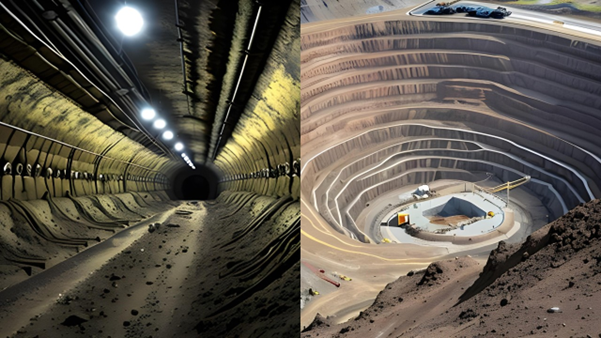Keys to a Successful Mine-site Valuation
Mine-site Evaluation
Written by Shripal Parekh and Charlie Liu
Introduction:
Exploration mines and acquisitions of these assets represent a significant opportunity for investors and businesses seeking to tap into the mineral resources beneath the Earth's surface. However, acquiring these mines involves intricate steps and considerations to minimize risks and ensure a fruitful investment.
This article and the accompanying Excel-based mine valuation model serve as a foundational guide for investors or businesses interested in acquiring exploration mines. The article highlights the high-level intricacies and provides an initial coverage of mineral types, mining methodologies, and important due diligence. The model provides a structured approach to estimating capital and operating expenditures and project revenues and performing financial modelling using discounted cash flow analysis, with metrics such as net present value (NPV) and internal rate of return (IRR).
To get your own copy of the supporting mine valuation model and play with the supporting drivers and formulas, please create and save your own copy of the Excel-based valuation model.
Identify Target Minerals:
The first step in the acquisition process is to perform a meticulous analysis to identify the minerals or resources of interest. Key considerations include:
Current and forecasted market demand and supply.
Pricing trends.
Potential regulatory constraints associated with the targeted minerals.
For this report and the accompanying model, we have assumed that the target minerals are Silver & Gold due to their attractive market fundamentals and versatile industrial applications.
Silver has seen growing industrial demand due to its superior electrical conductivity, antimicrobial properties, and applications in solar panels, electronics, and automotive industries. The transition towards green energy solutions and increasing demand for electric vehicles are expected to drive silver's industrial demand further.
Gold has historically been a valuable precious metal with consistent investment demand driven by its role as a safe-haven asset and a hedge against inflation and current economic uncertainty. Additionally, gold has diverse industrial and technological uses in electronics, dentistry, and aerospace, among others, ensuring steady demand.
Both metals are finite resources with limited global production, which can lead to supply deficits amid rising demand, supporting higher long-term price prospects. Their liquid trading markets also provide opportunities for effective hedging and risk management strategies.
Geological Assessment and Field Investigations:
Conducting comprehensive geological assessments and field investigations is pivotal when evaluating a potential mine site for acquisition. The geological assessments provide critical insights into the mineral composition, grade, and distribution within the deposit. At the same time, field investigations inform accurate cost estimations for site preparation, water management, and environmental compliance.
The accompanying Excel model's input sheet includes sections dedicated to capturing assumptions related to geological assessments and field investigations listed below.
Life of mine
Mined ore
Processed ore
Grades
Recovery rates
Treatment charges
Initial/sustaining/closing costs.
These assumptions are crucial for accurately estimating mineral resources, reserves, mine planning, and projecting financials. Significant changes could impact NPV and IRR calculations.
Mining Methodology and Operational Costs:
The choice of mining methodology depends on factors like deposit characteristics, ore grade, depth, economics, and environmental considerations. Detailed geological assessments, resource modelling, and feasibility studies are essential to determine the optimal mining approach. Additionally, modern techniques like automation, remote monitoring, and digital twin simulations can enhance productivity, safety, and sustainability in silver and gold mining operations. Consider the economic efficiency, safety, and resource recovery aspects of the selected mining method. For this report, we have considered the following common methods.
Open-pit Mining: Employed when economically valuable minerals are located near the Earth's surface. This technique involves the systematic removal of overburden to access mineral deposits with the help of heavy machinery, making it cost-effective for resources like gold or copper. This process necessitates thorough environmental impact assessment.
Quarrying: It is a mining process for extracting rocks and minerals from open-pit mines, but it focuses on common materials crucial for construction, such as limestone and granite.
Underground Mining: Employed to extract ores that are located beneath the Earth’s surface. It involves creating tunnels using equipment like drills. It offers an advantage regarding environmental impact but requires careful engineering to ensure stability and worker safety.
Underground & Open-pit Mining
For simplicity, our valuation model's input sheet includes sections for selecting the mining method and inputting operational cost assumptions like mining ($/t), processing ($/t), and G&A ($/t) costs at a high level. These assumptions, derived from geological assessments and field investigations, are essential for accurately estimating operating costs and profitability. Changes in these assumptions could adversely impact NPV and IRR.
Market Analysis:
A market analysis encompassing qualitative and quantitative factors is required for the potential acquisition of the mine. Qualitative assessment should consider global demand drivers for precious metals, such as industrial applications, investments, cultural significance, and supply dynamics influenced by new mine developments, operations, and regulations.
Our valuation model primarily considers the quantitative market aspects. We analyzed historical and projected silver and gold prices, incorporating a range of scenarios based on industrial demand, investment trends, supply dynamics, and expert forecasts. Our base case assumes average prices of $22.94 per ounce for silver and $2020.90 per ounce for gold over the projected life of the mine.
Additionally, we factored in the applicable royalties and taxes specific to the region, considering current rates and potential changes based on industry trends and regulatory developments.
While qualitative factors provide context, our valuation model focuses on the quantitative elements, particularly metal prices, royalties, taxes, and discount rates based on macroeconomics, to ensure a rigorous financial assessment of the potential acquisition.
Financial Model Outputs and Scenario Analysis:
Our valuation model’s output sheet provides the calculated NPV ($19 million) and IRR (23%) based on the input assumptions. It also performs scenario analysis using metal price and discount rate sensitivities, enabling evaluation under various market conditions. The outputs are highly sensitive to the input assumptions mentioned above. Changes to any of the assumptions and metal pricing fluctuations could result in significantly different NPV and IRR calculations. It is essential to note the model is very high-level and simplified for this article’s limited scope. This would be a more detailed model with 100s of operational and financial data points to deliver more accurate outputs in a real-world situation.
Due Diligence:
As part of any due diligence process for the potential acquisition of a Mine site, we recommend taking the necessary steps to thoroughly assess the legal, regulatory, environmental, and social aspects associated with the project.
Legal and Regulatory Compliance: We recommend conducting a detailed review of the mine's permitting status, including the effluent permit, air emissions permit, water license, and heritage inspection license.
Engaging with the local indigenous community is crucial, and we recommend continuing the existing consultations and adhering to agreed-upon protocols to maintain positive relations and community support.
The legal team should undertake a thorough review of existing contractual agreements, with a focus on resolving any lingering disputes or potential conflicts, such as the identified dispute with a local service provider.
Environmental and Social Impact:
We recommend a comprehensive review of the previous owners' Environmental Impact Assessment (EIA), with a particular focus on the identified risks related to air and water quality in the surrounding areas. Many mitigation measures should be implemented to ensure compliance, including air filtration systems and wastewater treatment facilities, or ongoing monitoring and potential upgrades should be provided.
Additionally, we suggest incorporating other relevant assessments, such as technical and financial due diligence, health and safety considerations, and mine closure and reclamation planning, to ensure a thorough evaluation of the potential acquisition.
As we focus on the financial valuations side of acquisition decision-making, the due diligence aspects are outside the scope of our model/study.
Establishing a Comprehensive Valuation Strategy:
Mine valuations should be integrated into an organization's strategic decision-making process, supporting acquisition decisions, ongoing operations, sustaining investments, and potential divestments/closures. As macroeconomic factors, prices, and operational realities evolve, regular valuations and scenario analyses become essential.
To support this comprehensive valuation strategy, robust processes, and systems enabling seamless data collection, automated calculations, reporting, and dashboarding are imperative. We have partnered with mining companies to implement cloud-based Enterprise Performance Management (EPM) solutions, streamlining data integration, automating calculations, and providing real-time visibility into performance indicators. These solutions empower data-driven decision-making throughout the mine's lifecycle. As you embark on your mine site evaluation and ongoing reporting process transformation journey, we encourage establishing a holistic valuation strategy supported by robust processes and systems. By doing so, you can facilitate informed decisions, effectively manage assets, optimize performance, and capitalize on emerging opportunities.
Conclusion:
Mine valuation demands a systematic approach encompassing geological assessments, field investigations, mining methodology selection, market analysis, and financial modelling. The accompanying Excel model provides a simplified high-level framework for evaluating potential acquisitions. By incorporating this report's assumptions and recommendations, companies can enhance the chances of successful acquisitions aligning with the overall portfolio and strategic objectives.
The provided model is a foundational tool; it is recommended that it be extended and customized to fit specific requirements. Furthermore, establishing a holistic valuation strategy supported by robust processes and systems can enable effective decision-making throughout the mine's lifecycle, from acquisition to operations and potential divestment or closure. Remember, while financial metrics and quantitative analysis are essential, the acquisition decision should also consider broader strategic considerations, risks, and opportunities.
I If you need help with creating a comprehensive valuation strategy or setting up supporting systems and processes, we would be happy to explore potential collaborations with you. Finaptive has helped hundreds of clients across various sectors like mining, insurance, SAAS, and CPG. They specialize in implementing financial modeling to support valuation and strategic forecasting. They also offer technical advisory services to improve business efficiency and data visibility. To schedule an initial advisory meeting with them free of charge, please contact https://finaptive.com.
Questions & Answers
What are the primary factors to consider when identifying target minerals for mine acquisition?
When identifying target minerals, it is crucial to consider the current and forecasted market demand and supply, pricing trends, and potential regulatory constraints. For example, our report assumes Silver & Gold as target minerals due to their strong market fundamentals and versatile industrial applications.
Why is geological assessment critical in the mine acquisition process?
Geological assessments are pivotal as they provide essential insights into the mineral composition, grade, and distribution within the deposit. These assessments help in making informed decisions regarding the viability and profitability of mining operations.
How do mining methodology and operational costs influence the financial viability of a mine?
The choice of mining methodology and the associated operational costs significantly impact the economic efficiency, safety, and environmental footprint of mining operations. Methods like open-pit mining, quarrying, and underground mining vary in cost-effectiveness and are chosen based on ore characteristics and depth.
What role does market analysis play in evaluating potential mine acquisitions?
Market analysis is crucial as it helps assess the qualitative and quantitative factors influencing the global demand and supply dynamics for precious metals. Our model, for instance, analyzes historical and projected prices of silver and gold, incorporating scenarios based on industry trends and forecasts.
How does the financial model calculate the potential investment's return?
The financial model outputs, including Net Present Value (NPV) and Internal Rate of Return (IRR), are calculated based on input assumptions such as metal prices, operational costs, and discount rates. Scenario analysis is performed to evaluate investment returns under various market conditions.
What are some key due diligence considerations when acquiring a mine?
Due diligence should thoroughly assess legal, regulatory, environmental, and social factors. This includes reviewing permits, engaging with local communities, and evaluating the environmental impacts. Ensuring compliance and understanding all associated risks are critical for a successful acquisition.
What are the key financial metrics used in the mine valuation model and why are they important?
The key financial metrics used in our mine valuation model include Net Present Value (NPV) and Internal Rate of Return (IRR). NPV provides a dollar value that represents the net value today of all future cash flows expected from the mine, adjusted for the time value of money. IRR is the annual return rate that makes the NPV equal to zero. These metrics are essential as they help investors evaluate the profitability and risk of the mining investment, ensuring that the returns justify the costs under various scenarios.
To meet the Finaptive team for initial advisory meeting with them free of charge to see how they can help you, please contact https://finaptive.com
About the Authors
Shripal Parekh, Founder, Finaptive Solutions
Charlie X.W. Liu,
Founder, Monte Carlos Consulting Inc.




